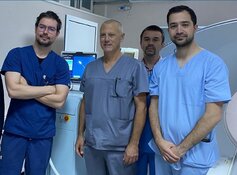The Life Sciences Report: The Patient Protection and Affordable Care Act (ACA/Obamacare) affects medtech both directly and indirectly. From that perspective, is the ACA an obvious obstacle to growth right now? Or is there potential upside from increased volumes of procedures?
William Plovanic: I would not expect the Affordable Care Act to bring incremental patients into the mix. I don't think any investors or device company executives believe this will be a benefit to device companies in general—or at all. It's a revenue stream for the government, and companies aren't going to gain in return per se.
TLSR: The ACA is an overall negative for medtech companies?
WP: They'll pay the tax, and do not expect more revenues, so yes, it would be an incremental negative. But the act (via the tax) is already baked into current expectations.
TLSR: With hospitals pressured to cut costs, do you see or hear them resisting newer, higher-margin devices, instrumentation and implants?
WP: We have not heard of any particular increased pushback on pricing relative to ACA.
TLSR: You've written recently that the last two years have been challenging and disappointing with the decline of procedure volume growth rates in orthopedics. Was this a function of baby boomers becoming unemployed and unable to have elective surgeries?
WP: Absolutely. That is a big part of it. The more discretionary the procedure, the more likely volumes decreased or growth rates declined. Looking at the numbers, hip implants have held up rather well from a procedural standpoint, whereas knees have not at all.
"At this point in time companies are repositioning businesses and infrastructure to grow at low- to mid-single-digit rates."
The question we're all asking is: Does the growth come back? We know that the American Academy of Orthopaedic Surgeons (AAOS) has done some work on demographic and other drivers of knee implants (as have we), and these studies show that knees should grow in double digits. But that's nothing near what we're seeing right now.
To answer your question, at this point in time companies are repositioning businesses and infrastructure to grow at low- to mid-single-digit rates. If that changes and growth accelerates, I'm sure they'll adapt. From the discussions I've had with companies, they are more focused on the current growth-rate environment and how to best maximize earnings or cash flow in this type of period.
TLSR: Currently, what are the growth drivers in your coverage space?
WP: With medical devices, the way you typically grow a company is to develop a product that is either slightly different or very differentiated from what is already on the market. You build a better mousetrap, or a whole new way of solving a problem. Next, you gain a group of adopters. Then you fill out the product offering so that you're able to capture as much revenue from a given procedure or physician/physician group as possible. After that it is all about expansion of distribution to capture more surgeons. Products and distribution tend to drive smaller companies as well as the larger ones.
The advantage of a new technology, a new product, a mousetrap that is a little better or a lot better, is that you will drive higher pricing. Of course, if you are just starting up, it will drive a significantly higher price. If you are building an existing company, it will help offset price degradation in your core, commoditized product lines.
TLSR: With pressures on margins, are companies inclined not to innovate? Or are they more motivated to innovate?
WP: They are more motivated. The environment over the last three years has become extremely challenging. Developers have been focused on healthcare reform, but that's not what slowed down innovation in medical devices. Significant changes to the rules at the U.S. Food and Drug Administration (FDA) and in the ability to gain reimbursement from the Centers for Medicare & Medicaid Services (CMS) have made things much more difficult—developing a new product has become nearly impossible in the U.S. If a company or investor doesn't know what its risks are and how to quantify those risks, especially with regard to the FDA and/or CMS, then how can a company or investor make that initial investment? Think for a moment about venture capitalists in medtech. They don't know what the potential return will be if they can't quantify the risks and the timeline to gain FDA clearance, and then reimbursement.
TLSR: We seem to have gotten some relief on the drug side, with Prescription Drug User Fee Act (PDUFA) IV and its results. We've started to get early approvals of drugs, several of which we saw in 2012. Is there nothing like that in the offing for medical devices?
WP: No. A little more guidance and clarity from the FDA might be forthcoming. It's not clear in many cases what the FDA requirements are to gain clearance or approval, depending upon whether the regulatory pathway is a 510(k) (premarket notification) or a premarket approval (PMA). More importantly, it is more difficult to gain a clear pathway for FDA approval, and then reimbursement, for PMA devices, which are truly game-changing devices that impact the practice of care or outcomes for patients.
TLSR: With that, I'd like to talk about some companies. Go ahead with your best idea.
WP: Our top growth picks for 2013 are Dexcom Inc. (DXCM:NASDAQ) and Insulet Corp. (PODD:NASDAQ).
TLSR: They are both diabetes companies. Can you talk about them?
WP: Going back to a previous question about what drives medical device companies, new products tend to be the basic drivers. Both of these companies have new product approvals from the FDA. In the case of Dexcom, it was PMA clearance of its Dexcom G4 Platinum Continuous Glucose Monitor, with improved accuracy in the hypoglycemic range. In the case of Insulet, it's FDA clearance for its 510(k) device, the second-generation OmniPod System, improving on its first-ever tubeless insulin pump. The second-generation OmniPod is smaller and lighter than the original, with the same 200-unit insulin capacity.
"With medical devices, the way to grow a company is to develop a product that is different from what is already on the market."
The financial benefit to both companies is significantly improved gross and operating margins. Both were fast-growing medical device companies as they were, and with these newer products they will maintain, if not accelerate, top-line growth rates.
TLSR: Both companies have $1 billion ($1B) market caps. They are growth stories, is that right?
WP: Oh, yes. Our target price on Dexcom is $19, and $29 for Insulet. They are our two top growth picks.
TLSR: Do you have another growth story?
WP: There are not a lot of fast-growth companies out there in medical devices today. It depends how you define growth. One of our top value picks could be defined as a growth play: It is Globus Medical Inc. (GMED:NYSE), which develops and distributes implants for spinal fusion. It is growing its top line 10–15% per year. Its bottom line should grow at least 10–15% per year. It has numerous new product cycles, but nothing specific that we can point to as a game changer. It's more about the stock having a very inexpensive valuation. It trades at about seven times its 2013 enterprise value before interest, taxes, depreciation and amortization (EV:EBITDA). Top line growth is at 10–15% and so is EV:EBIDTA growth. Its competitors in the space trade at about 7–9 EV:EBITDA, with revenue growth rates that are only one-half or one-third of those of Globus.
TLSR: Globus is a $1.5B company, and it's up 15% over the past four weeks, but you have said it's still in the penalty box. Why?
WP: Globus preannounced Q4/12, which beat estimates and was obviously a solid quarter. But the company is in the penalty box for missing its first public quarter post the initial public offering, which was Q3/12. It missed its top line by maybe $500,000 in revenue, and the bottom line by $0.01 per share. Fundamentally, Q3/12 was a challenging quarter for the spine segment of orthopedics in general. But Globus, specifically, had very difficult year-over-year comparables, and a new business segment did not start ramping up as expected.
The business continues to move forward and do well. As we move through 2013, the company should be able to meet or exceed expectations, proving it can grow the top line 10–15% and the bottom line by the same 10–15%. As it becomes more consistent in performance, then we believe investors will likely come back to the stock.
TLSR: Are there some smaller-cap names you can talk about?
WP: Solta Medical Inc. (SLTM:NASDAQ), which specializes in dynamic energy devices for the medical aesthetics market, is a very good growth story. Last year it acquired a product line called Liposonix from Medicis Pharmaceutical Corp. (Medicis is now part of Valeant Pharmaceuticals International Inc. [VRX:NYSE; VRX:TSX].) The Liposonix product is a noninvasive fat ablation therapy that is nonsurgical and has done extremely well. Solta recently announced acquisition of a company called Sound Surgical Technologies LLC, an invasive fat removal company, which is complementary to its noninvasive fat ablation Liposonix platform. The Sound Surgical technique utilizes ultrasound with liposuction to get better results with less pain, less bleeding, less bruising and better outcomes. It's a great acquisition, and it will close in the next couple of weeks.
TLSR: Will the company have to maintain separate sales forces for these new units?
WP: Solta has stated that it will keep two separate sales forces, which makes a lot of sense. The invasive liposuction product by Sound Surgical is sold to plastic surgeons (plastics), versus the other products—dynamic energy, laser, radiofrequency, ultrasound—which are sold to both plastics and dermatologists, for the most part. There will be some overlap, but not a whole lot.
"The advantage of a new technology, a new product, a better mousetrap, is that you will drive higher pricing."
But the company wants to keep distribution channels intact because many of Solta's existing dynamic energy devices are sold to plastics, and they may not have relationships with the Sound Surgical reps. Being an operating room rep versus an office-based rep is different.
TLSR: What about another growth story?
WP: As far as growth companies go, NuVasive Inc. (NUVA:NASDAQ) is another player in spine, and it's one of my value picks for the year. The company's core growth rate is in the mid-single-digit range. There is a lot of earnings leverage potential with NuVasive. It's a value play because it's a show-me story. The company needs to show that it can string together two, three, four quarters, and the stock should perform significantly. We have a $19 price target. As NuVasive continues to perform, that will have an impact on the valuation metrics utilized for the stock.
TLSR: Are the growth drivers the cervical disc and the biologics platforms that the company is coming out with?
WP: The near-term drivers are cervical disc and international growth, with Japan coming online. The biologics platform, I believe, is an out-year driver. The company already has a biologic product, Osteocel Plus, and its new product is a cannibalization of an existing one, with plans to expand on them with another product line. At this point, NuVasive is showing growth in the mid- to high-single digits, outgrowing the market, but still not significant. Again, stringing together a couple of solid quarters and seeing operating leverage are the drivers for this name.
TLSR: You also follow RTI Biologics Inc. (RTIX:NASDAQ). Can you talk about it? The stock was up 18% over the past four weeks and 34% over the past six months, until Q4/12 earnings. Post-earnings, RTI shares gave up all of those gains.
WP: The stock has made a significant move recently. We knew of no reason for the move up. However, the move down was because, even though RTI reported Q4/12 results that were in-line, 2013 guidance was disappointing. This year will be transitional for the company, as new products are commercialized by a new sales force (that is being built) and an outstanding FDA warning letter continues to impact sales. Once the FDA warning letter issues are cleared, a new porcine dermis product for hernia repair gains FDA clearance, and processing of a new stem cell product is able to produce commercial quantities, we believe the stock could rebound.
TLSR: I've enjoyed being with you, Bill. Thank you for taking the time.
WP: Thank you, George.
William Plovanic joined Canaccord Genuity in 2007 as a managing director and medical technology equity research analyst. He has been a publishing sellside analyst with coverage of medical devices for more than 17 years. Plovanic's areas of coverage include orthopedics, diabetes, obesity, neurotechnologies, dialysis, aesthetics and wound care. In 2009 Plovanic was ranked as the #2 Earnings Estimator for Health Care Equipment and Supplies by Starmine. In 2003 and 2004, Plovanic was selected as a Wall Street Journal "All Star Analyst" in the medical device sector and in 2002 was the #1-ranked analyst by Starmine for stock-picking and performance in the medical technology sector. Plovanic is a frequent presenter at medical and industry meetings. Plovanic graduated from Bradley University with a bachelor's degree in finance, and is a Chartered Financial Analyst.
Want to read more Life Sciences Report interviews like this? Sign up for our free e-newsletter, and you'll learn when new articles have been published. To see a list of recent interviews with industry analysts and commentators, visit our Streetwise Interviews page.
DISCLOSURE:
1) George S. Mack of The Life Sciences Report conducted this interview. He personally and/or his family own shares of the following companies mentioned in this interview: None.
2) The following companies mentioned in the interview are sponsors of The Life Sciences Report: None. Streetwise Reports does not accept stock in exchange for services. Interviews are edited for clarity.
3) William Plovanic: I personally and/or my family own shares of the following companies mentioned in this interview: None. I personally and/or my family am paid by the following companies mentioned in this interview: Globus Medical Inc. and Solta Medical are investment banking clients of Canaccord Genuity Inc. View disclosures by clicking here.
4) Additional information, including disclosures regarding all securities under research coverage, is available at http://www.canaccordgenuity.com/en/ODD/pages/disclosures.aspx. I was not paid by Streetwise for participating in this story.




































